Evaluating CSR's Impact on Marketing, Profitability: John Lewis
VerifiedAdded on 2020/01/16
|20
|4588
|283
Report
AI Summary
This report examines the impact of Corporate Social Responsibility (CSR) on the marketing department of the John Lewis Partnership, aiming to understand how CSR promotes profitability and financial sustainability. The study begins with an introduction to CSR, its conceptual framework, and the research objectives, questions, and project management plan. The project plan includes activities, costs, timescales, team coordination, and risk management. A Gantt chart and work breakdown structure are presented to illustrate the project's timeline and component breakdown. The research methodology section details the research design (descriptive), philosophy (interpretivism), approach (inductive), data collection methods (primary and secondary), and data analysis techniques (thematic analysis). The report also acknowledges research limitations, such as time and financial constraints. The findings aim to assess the role of CSR in enhancing profitability and sustainability within John Lewis, offering recommendations for improvement. The report explores various aspects of the research, including research methodologies, data collection, and analysis, to provide a comprehensive overview of the impact of CSR on marketing strategies and overall business performance. The conclusion and recommendations provide insights into how John Lewis can further leverage CSR to achieve its business goals.
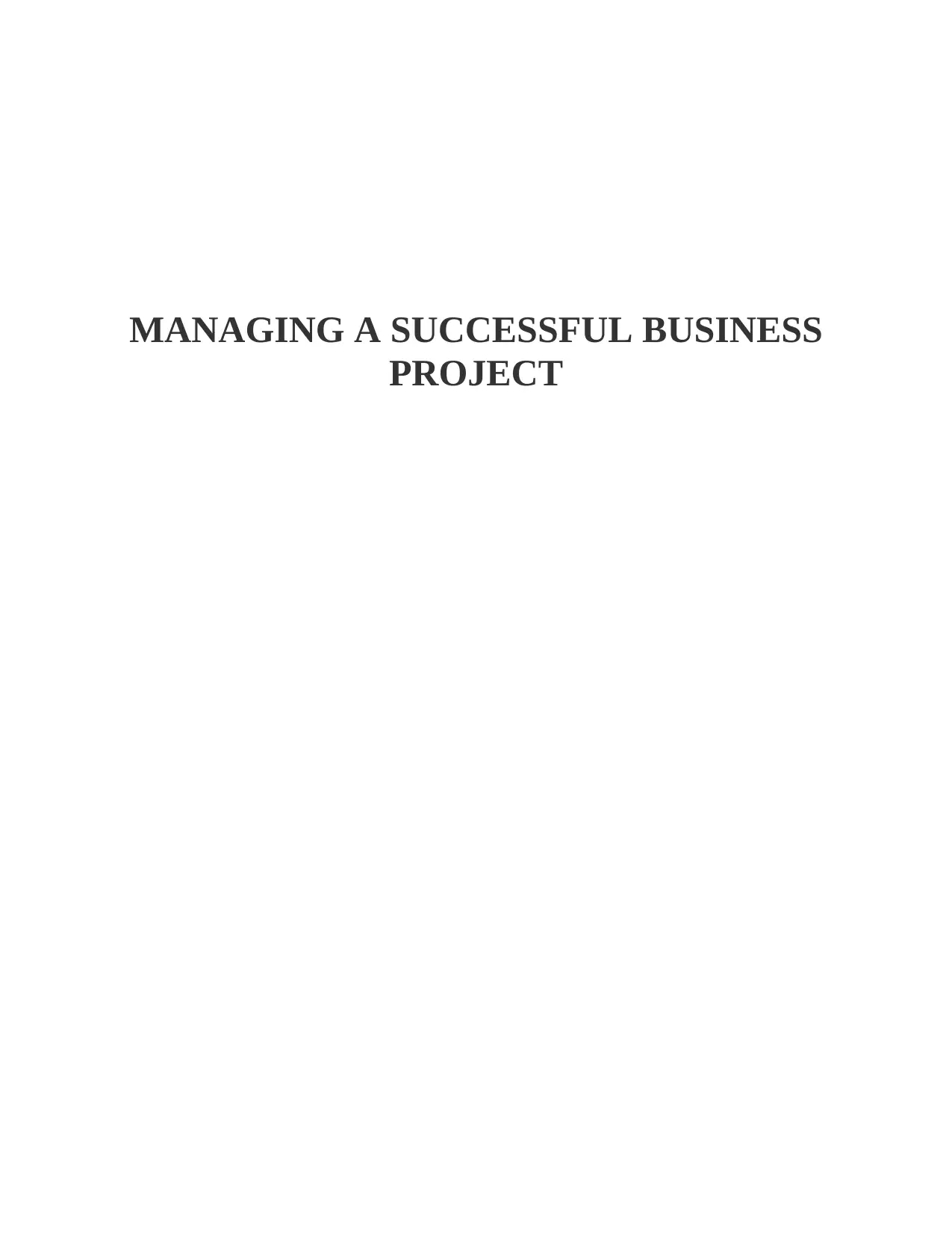
MANAGING A SUCCESSFUL BUSINESS
PROJECT
PROJECT
Paraphrase This Document
Need a fresh take? Get an instant paraphrase of this document with our AI Paraphraser
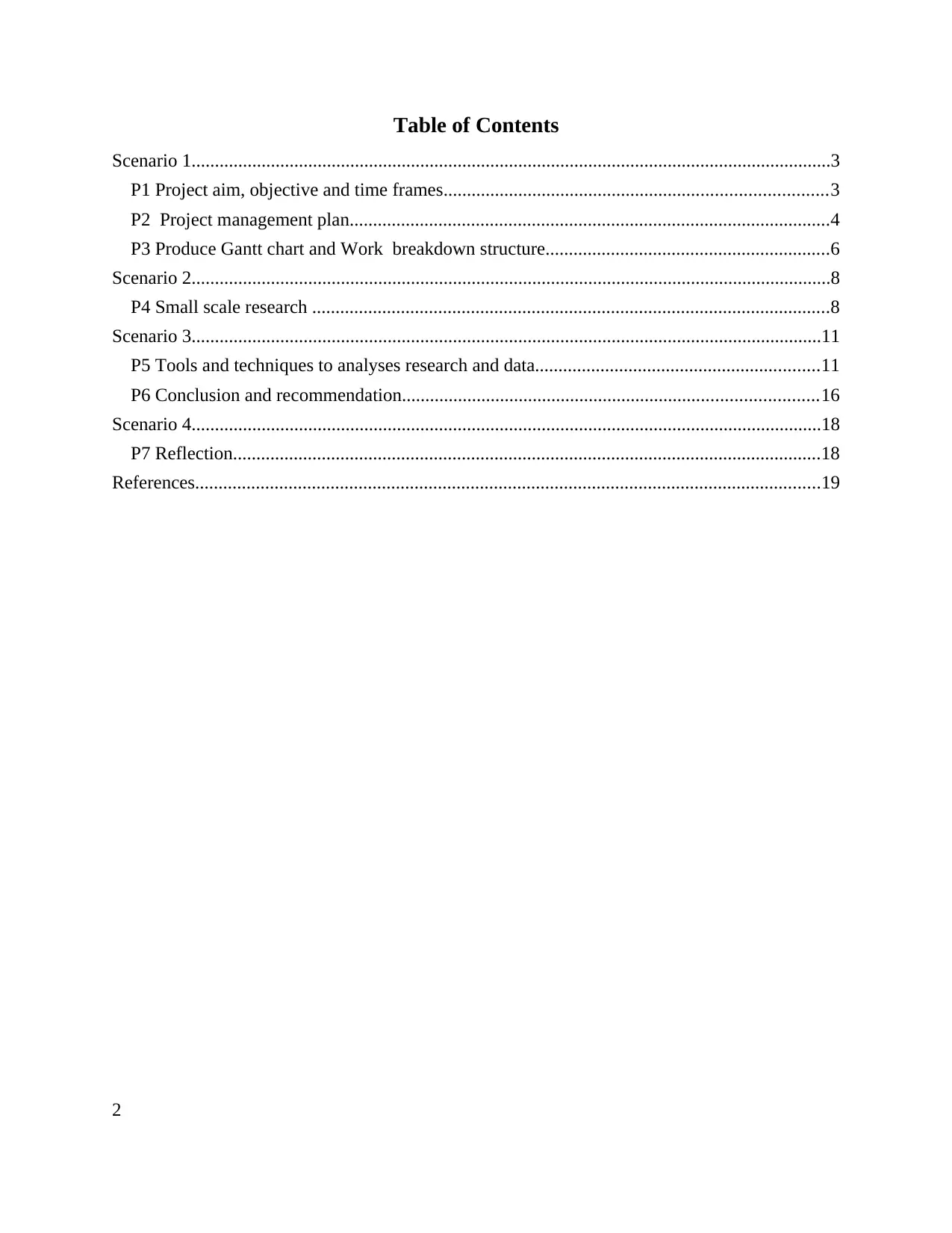
Table of Contents
Scenario 1.........................................................................................................................................3
P1 Project aim, objective and time frames..................................................................................3
P2 Project management plan.......................................................................................................4
P3 Produce Gantt chart and Work breakdown structure.............................................................6
Scenario 2.........................................................................................................................................8
P4 Small scale research ...............................................................................................................8
Scenario 3.......................................................................................................................................11
P5 Tools and techniques to analyses research and data.............................................................11
P6 Conclusion and recommendation.........................................................................................16
Scenario 4.......................................................................................................................................18
P7 Reflection..............................................................................................................................18
References......................................................................................................................................19
2
Scenario 1.........................................................................................................................................3
P1 Project aim, objective and time frames..................................................................................3
P2 Project management plan.......................................................................................................4
P3 Produce Gantt chart and Work breakdown structure.............................................................6
Scenario 2.........................................................................................................................................8
P4 Small scale research ...............................................................................................................8
Scenario 3.......................................................................................................................................11
P5 Tools and techniques to analyses research and data.............................................................11
P6 Conclusion and recommendation.........................................................................................16
Scenario 4.......................................................................................................................................18
P7 Reflection..............................................................................................................................18
References......................................................................................................................................19
2
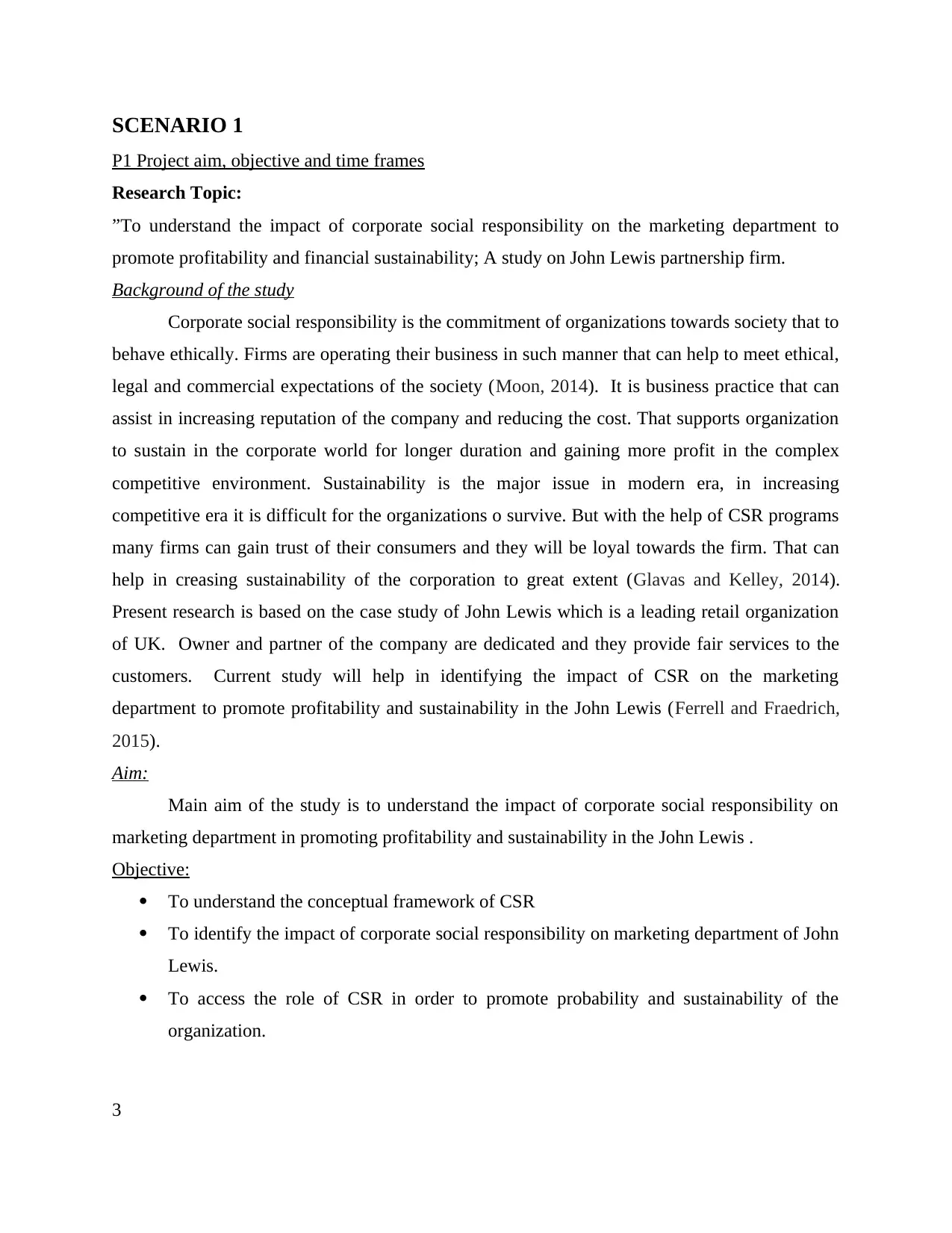
SCENARIO 1
P1 Project aim, objective and time frames
Research Topic:
”To understand the impact of corporate social responsibility on the marketing department to
promote profitability and financial sustainability; A study on John Lewis partnership firm.
Background of the study
Corporate social responsibility is the commitment of organizations towards society that to
behave ethically. Firms are operating their business in such manner that can help to meet ethical,
legal and commercial expectations of the society (Moon, 2014). It is business practice that can
assist in increasing reputation of the company and reducing the cost. That supports organization
to sustain in the corporate world for longer duration and gaining more profit in the complex
competitive environment. Sustainability is the major issue in modern era, in increasing
competitive era it is difficult for the organizations o survive. But with the help of CSR programs
many firms can gain trust of their consumers and they will be loyal towards the firm. That can
help in creasing sustainability of the corporation to great extent (Glavas and Kelley, 2014).
Present research is based on the case study of John Lewis which is a leading retail organization
of UK. Owner and partner of the company are dedicated and they provide fair services to the
customers. Current study will help in identifying the impact of CSR on the marketing
department to promote profitability and sustainability in the John Lewis (Ferrell and Fraedrich,
2015).
Aim:
Main aim of the study is to understand the impact of corporate social responsibility on
marketing department in promoting profitability and sustainability in the John Lewis .
Objective:
To understand the conceptual framework of CSR
To identify the impact of corporate social responsibility on marketing department of John
Lewis.
To access the role of CSR in order to promote probability and sustainability of the
organization.
3
P1 Project aim, objective and time frames
Research Topic:
”To understand the impact of corporate social responsibility on the marketing department to
promote profitability and financial sustainability; A study on John Lewis partnership firm.
Background of the study
Corporate social responsibility is the commitment of organizations towards society that to
behave ethically. Firms are operating their business in such manner that can help to meet ethical,
legal and commercial expectations of the society (Moon, 2014). It is business practice that can
assist in increasing reputation of the company and reducing the cost. That supports organization
to sustain in the corporate world for longer duration and gaining more profit in the complex
competitive environment. Sustainability is the major issue in modern era, in increasing
competitive era it is difficult for the organizations o survive. But with the help of CSR programs
many firms can gain trust of their consumers and they will be loyal towards the firm. That can
help in creasing sustainability of the corporation to great extent (Glavas and Kelley, 2014).
Present research is based on the case study of John Lewis which is a leading retail organization
of UK. Owner and partner of the company are dedicated and they provide fair services to the
customers. Current study will help in identifying the impact of CSR on the marketing
department to promote profitability and sustainability in the John Lewis (Ferrell and Fraedrich,
2015).
Aim:
Main aim of the study is to understand the impact of corporate social responsibility on
marketing department in promoting profitability and sustainability in the John Lewis .
Objective:
To understand the conceptual framework of CSR
To identify the impact of corporate social responsibility on marketing department of John
Lewis.
To access the role of CSR in order to promote probability and sustainability of the
organization.
3
⊘ This is a preview!⊘
Do you want full access?
Subscribe today to unlock all pages.

Trusted by 1+ million students worldwide
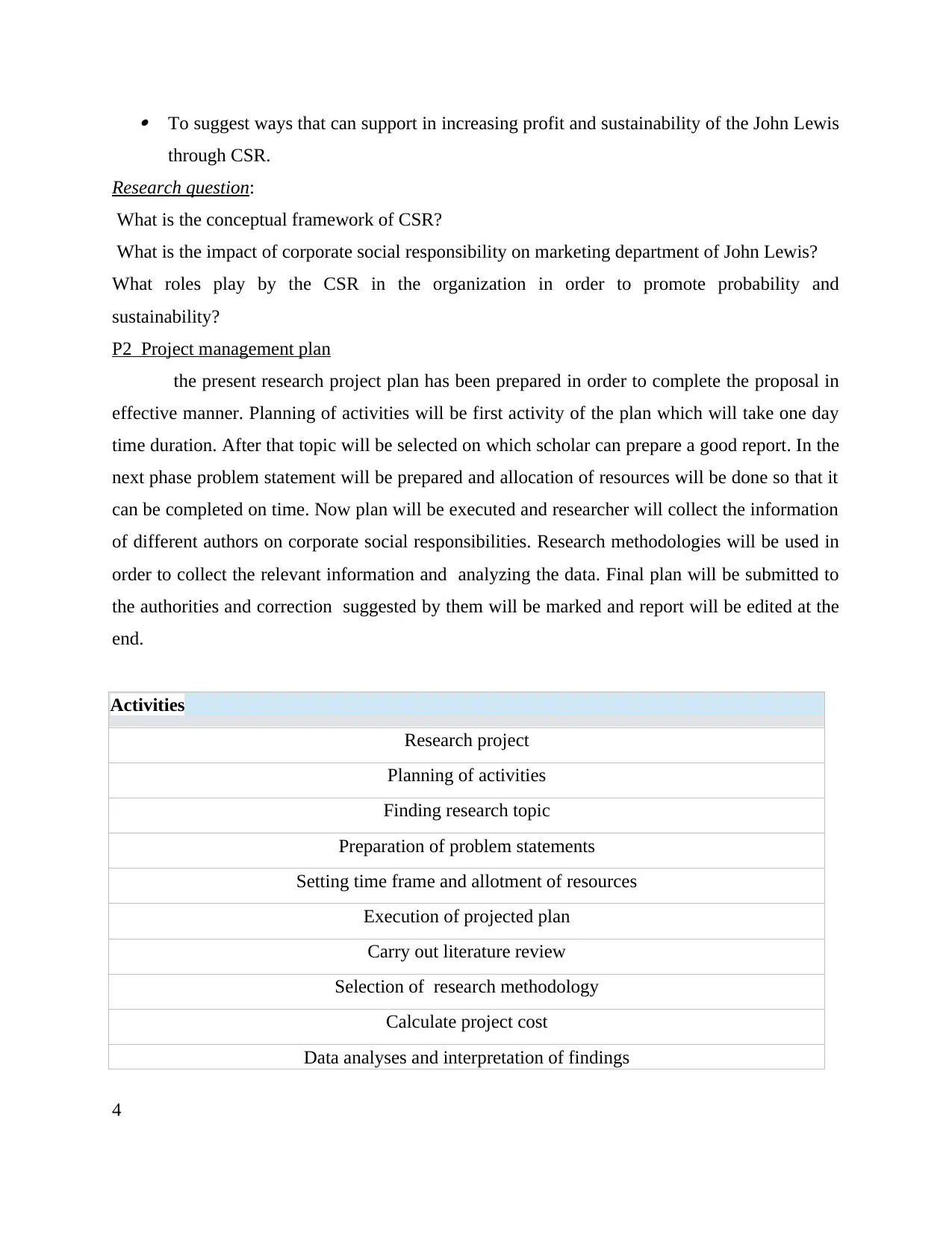
To suggest ways that can support in increasing profit and sustainability of the John Lewis
through CSR.
Research question:
What is the conceptual framework of CSR?
What is the impact of corporate social responsibility on marketing department of John Lewis?
What roles play by the CSR in the organization in order to promote probability and
sustainability?
P2 Project management plan
the present research project plan has been prepared in order to complete the proposal in
effective manner. Planning of activities will be first activity of the plan which will take one day
time duration. After that topic will be selected on which scholar can prepare a good report. In the
next phase problem statement will be prepared and allocation of resources will be done so that it
can be completed on time. Now plan will be executed and researcher will collect the information
of different authors on corporate social responsibilities. Research methodologies will be used in
order to collect the relevant information and analyzing the data. Final plan will be submitted to
the authorities and correction suggested by them will be marked and report will be edited at the
end.
Activities
Research project
Planning of activities
Finding research topic
Preparation of problem statements
Setting time frame and allotment of resources
Execution of projected plan
Carry out literature review
Selection of research methodology
Calculate project cost
Data analyses and interpretation of findings
4
through CSR.
Research question:
What is the conceptual framework of CSR?
What is the impact of corporate social responsibility on marketing department of John Lewis?
What roles play by the CSR in the organization in order to promote probability and
sustainability?
P2 Project management plan
the present research project plan has been prepared in order to complete the proposal in
effective manner. Planning of activities will be first activity of the plan which will take one day
time duration. After that topic will be selected on which scholar can prepare a good report. In the
next phase problem statement will be prepared and allocation of resources will be done so that it
can be completed on time. Now plan will be executed and researcher will collect the information
of different authors on corporate social responsibilities. Research methodologies will be used in
order to collect the relevant information and analyzing the data. Final plan will be submitted to
the authorities and correction suggested by them will be marked and report will be edited at the
end.
Activities
Research project
Planning of activities
Finding research topic
Preparation of problem statements
Setting time frame and allotment of resources
Execution of projected plan
Carry out literature review
Selection of research methodology
Calculate project cost
Data analyses and interpretation of findings
4
Paraphrase This Document
Need a fresh take? Get an instant paraphrase of this document with our AI Paraphraser
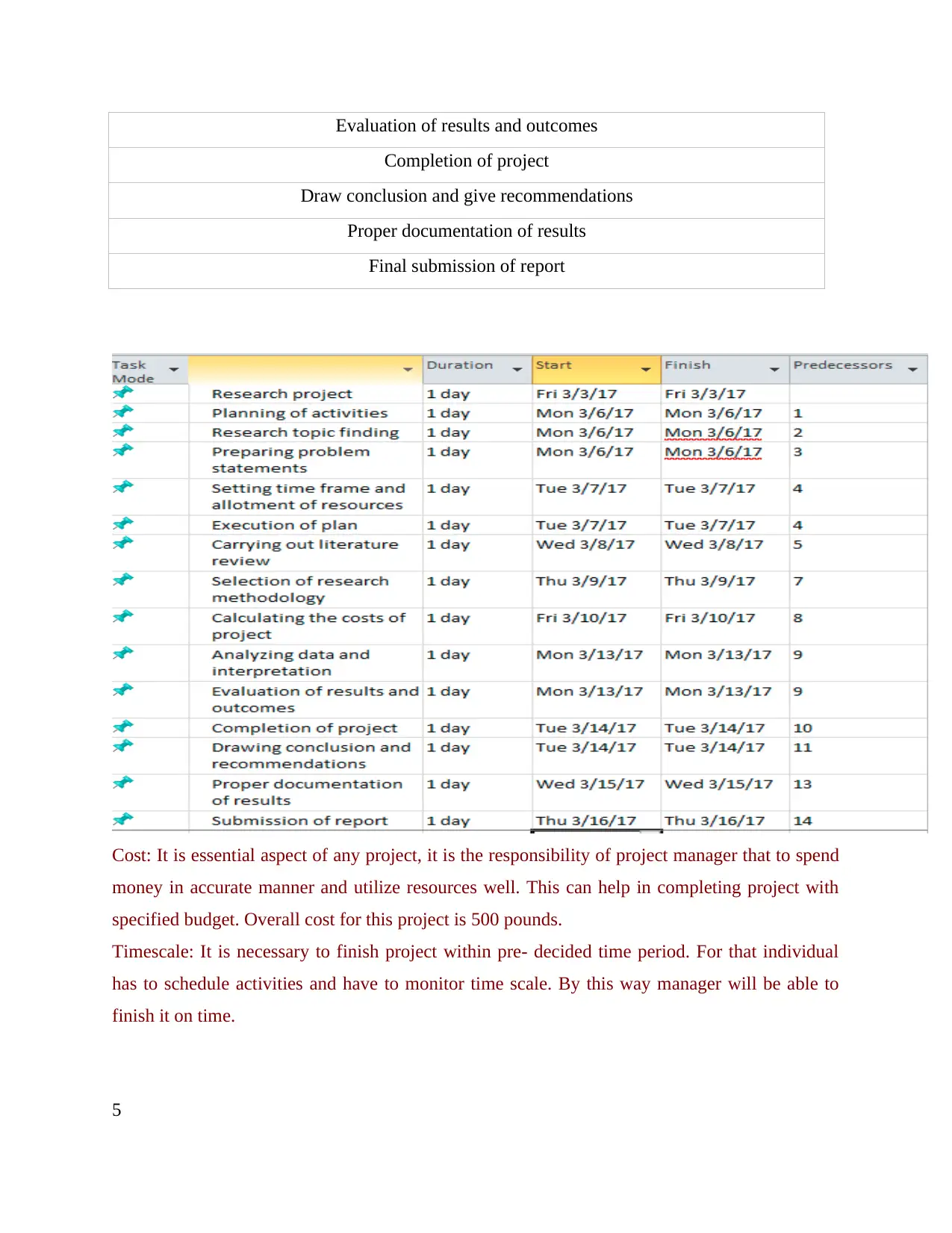
Evaluation of results and outcomes
Completion of project
Draw conclusion and give recommendations
Proper documentation of results
Final submission of report
Cost: It is essential aspect of any project, it is the responsibility of project manager that to spend
money in accurate manner and utilize resources well. This can help in completing project with
specified budget. Overall cost for this project is 500 pounds.
Timescale: It is necessary to finish project within pre- decided time period. For that individual
has to schedule activities and have to monitor time scale. By this way manager will be able to
finish it on time.
5
Completion of project
Draw conclusion and give recommendations
Proper documentation of results
Final submission of report
Cost: It is essential aspect of any project, it is the responsibility of project manager that to spend
money in accurate manner and utilize resources well. This can help in completing project with
specified budget. Overall cost for this project is 500 pounds.
Timescale: It is necessary to finish project within pre- decided time period. For that individual
has to schedule activities and have to monitor time scale. By this way manager will be able to
finish it on time.
5
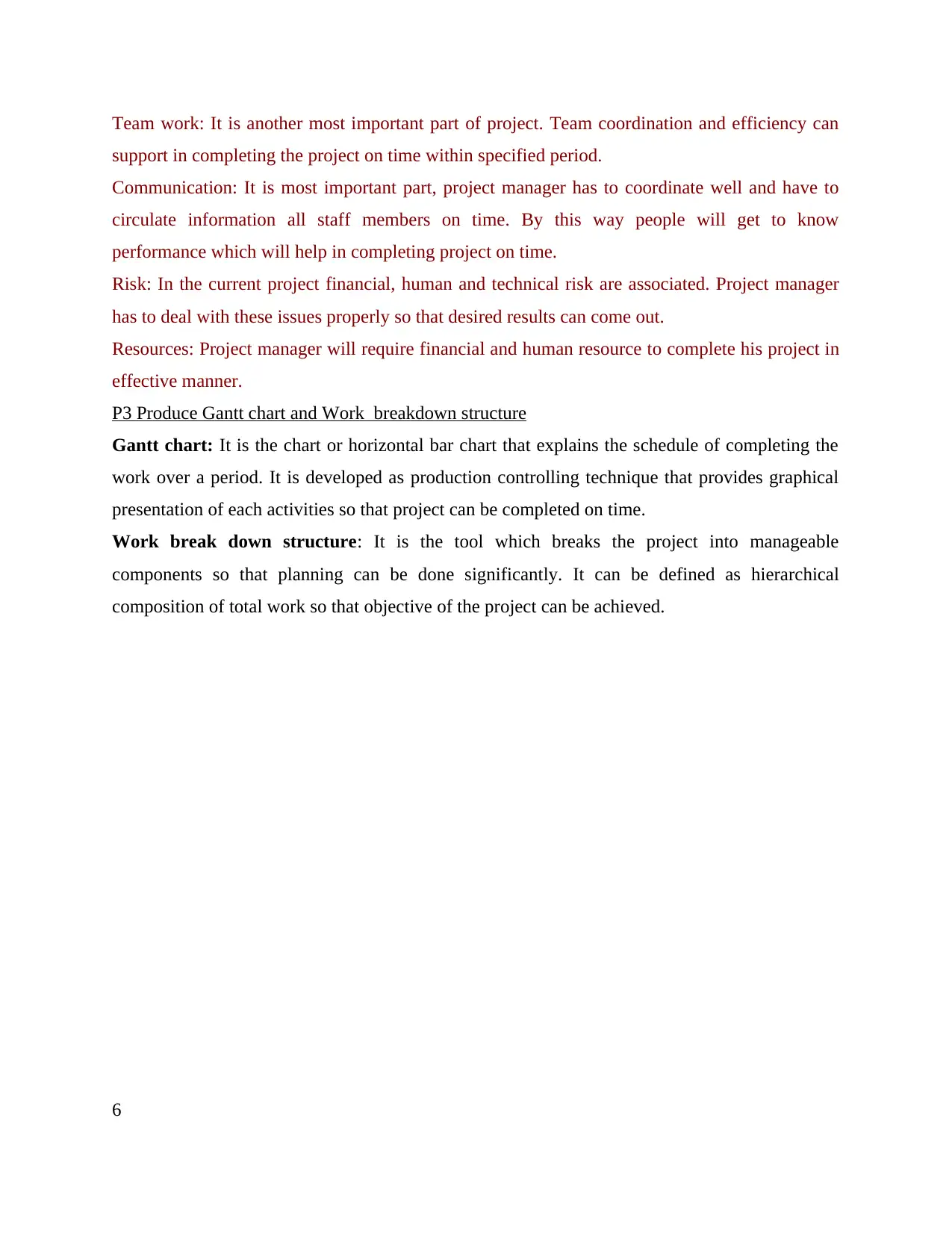
Team work: It is another most important part of project. Team coordination and efficiency can
support in completing the project on time within specified period.
Communication: It is most important part, project manager has to coordinate well and have to
circulate information all staff members on time. By this way people will get to know
performance which will help in completing project on time.
Risk: In the current project financial, human and technical risk are associated. Project manager
has to deal with these issues properly so that desired results can come out.
Resources: Project manager will require financial and human resource to complete his project in
effective manner.
P3 Produce Gantt chart and Work breakdown structure
Gantt chart: It is the chart or horizontal bar chart that explains the schedule of completing the
work over a period. It is developed as production controlling technique that provides graphical
presentation of each activities so that project can be completed on time.
Work break down structure: It is the tool which breaks the project into manageable
components so that planning can be done significantly. It can be defined as hierarchical
composition of total work so that objective of the project can be achieved.
6
support in completing the project on time within specified period.
Communication: It is most important part, project manager has to coordinate well and have to
circulate information all staff members on time. By this way people will get to know
performance which will help in completing project on time.
Risk: In the current project financial, human and technical risk are associated. Project manager
has to deal with these issues properly so that desired results can come out.
Resources: Project manager will require financial and human resource to complete his project in
effective manner.
P3 Produce Gantt chart and Work breakdown structure
Gantt chart: It is the chart or horizontal bar chart that explains the schedule of completing the
work over a period. It is developed as production controlling technique that provides graphical
presentation of each activities so that project can be completed on time.
Work break down structure: It is the tool which breaks the project into manageable
components so that planning can be done significantly. It can be defined as hierarchical
composition of total work so that objective of the project can be achieved.
6
⊘ This is a preview!⊘
Do you want full access?
Subscribe today to unlock all pages.

Trusted by 1+ million students worldwide
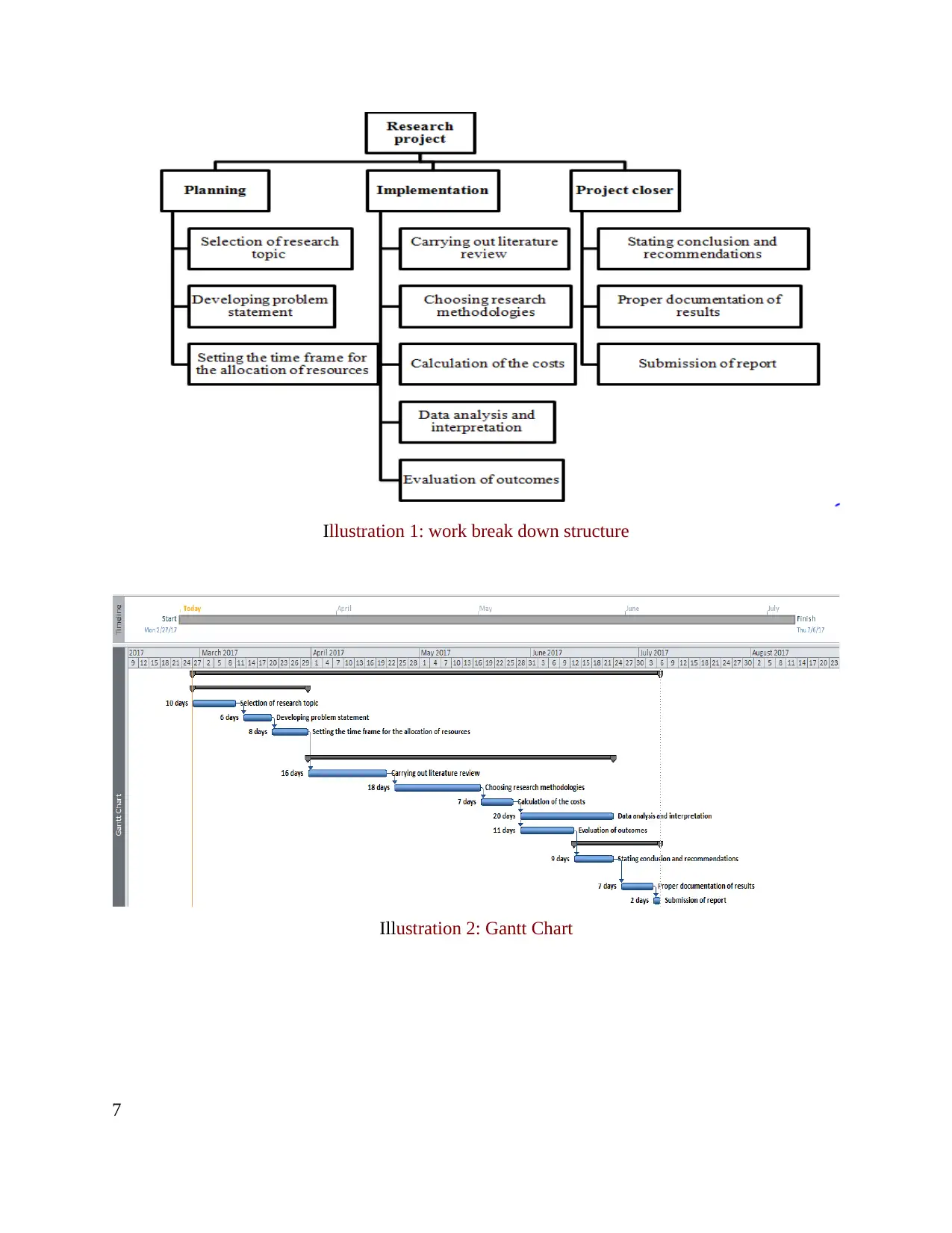
Illustration 1: work break down structure
7
Illustration 2: Gantt Chart
7
Illustration 2: Gantt Chart
Paraphrase This Document
Need a fresh take? Get an instant paraphrase of this document with our AI Paraphraser
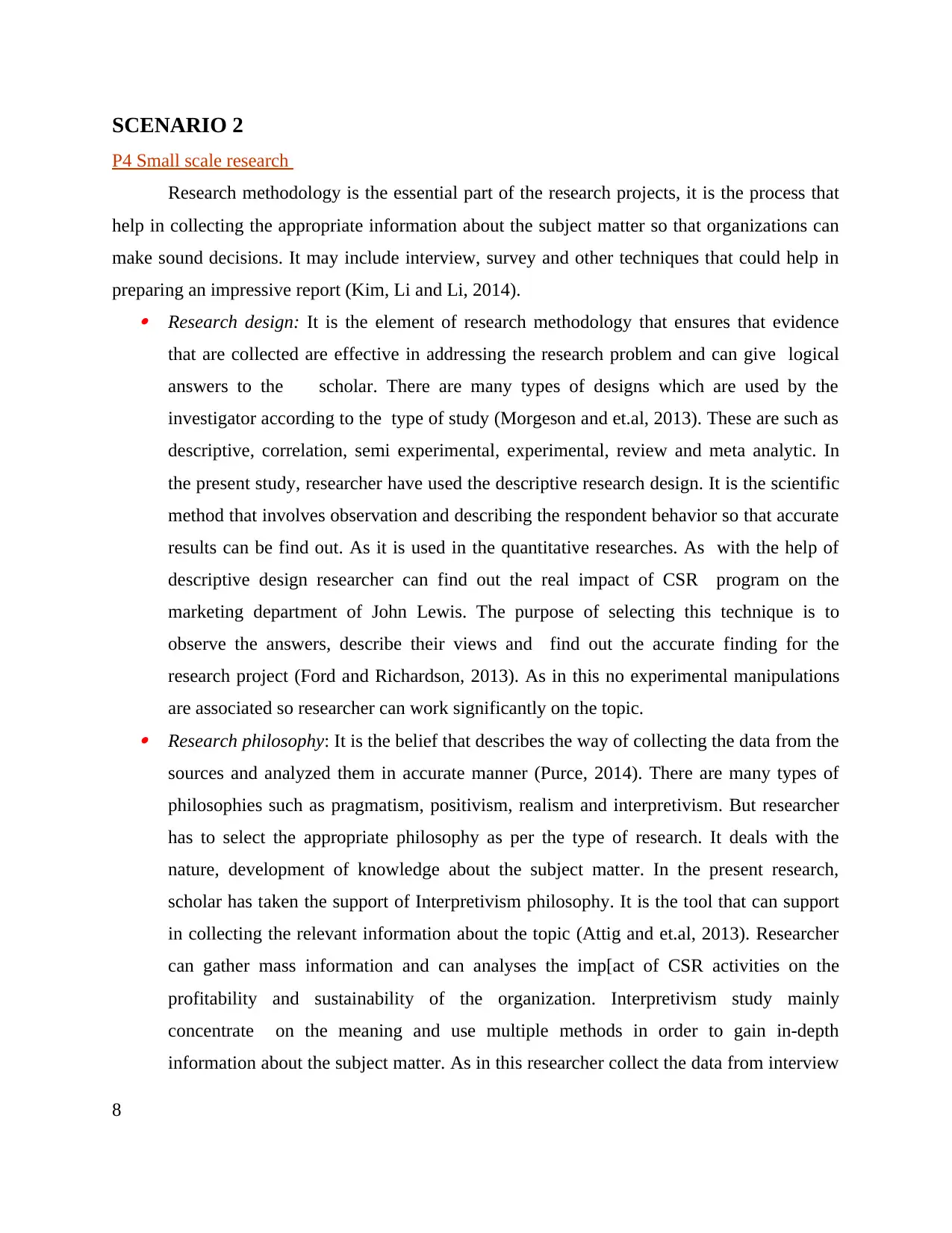
SCENARIO 2
P4 Small scale research
Research methodology is the essential part of the research projects, it is the process that
help in collecting the appropriate information about the subject matter so that organizations can
make sound decisions. It may include interview, survey and other techniques that could help in
preparing an impressive report (Kim, Li and Li, 2014). Research design: It is the element of research methodology that ensures that evidence
that are collected are effective in addressing the research problem and can give logical
answers to the scholar. There are many types of designs which are used by the
investigator according to the type of study (Morgeson and et.al, 2013). These are such as
descriptive, correlation, semi experimental, experimental, review and meta analytic. In
the present study, researcher have used the descriptive research design. It is the scientific
method that involves observation and describing the respondent behavior so that accurate
results can be find out. As it is used in the quantitative researches. As with the help of
descriptive design researcher can find out the real impact of CSR program on the
marketing department of John Lewis. The purpose of selecting this technique is to
observe the answers, describe their views and find out the accurate finding for the
research project (Ford and Richardson, 2013). As in this no experimental manipulations
are associated so researcher can work significantly on the topic. Research philosophy: It is the belief that describes the way of collecting the data from the
sources and analyzed them in accurate manner (Purce, 2014). There are many types of
philosophies such as pragmatism, positivism, realism and interpretivism. But researcher
has to select the appropriate philosophy as per the type of research. It deals with the
nature, development of knowledge about the subject matter. In the present research,
scholar has taken the support of Interpretivism philosophy. It is the tool that can support
in collecting the relevant information about the topic (Attig and et.al, 2013). Researcher
can gather mass information and can analyses the imp[act of CSR activities on the
profitability and sustainability of the organization. Interpretivism study mainly
concentrate on the meaning and use multiple methods in order to gain in-depth
information about the subject matter. As in this researcher collect the data from interview
8
P4 Small scale research
Research methodology is the essential part of the research projects, it is the process that
help in collecting the appropriate information about the subject matter so that organizations can
make sound decisions. It may include interview, survey and other techniques that could help in
preparing an impressive report (Kim, Li and Li, 2014). Research design: It is the element of research methodology that ensures that evidence
that are collected are effective in addressing the research problem and can give logical
answers to the scholar. There are many types of designs which are used by the
investigator according to the type of study (Morgeson and et.al, 2013). These are such as
descriptive, correlation, semi experimental, experimental, review and meta analytic. In
the present study, researcher have used the descriptive research design. It is the scientific
method that involves observation and describing the respondent behavior so that accurate
results can be find out. As it is used in the quantitative researches. As with the help of
descriptive design researcher can find out the real impact of CSR program on the
marketing department of John Lewis. The purpose of selecting this technique is to
observe the answers, describe their views and find out the accurate finding for the
research project (Ford and Richardson, 2013). As in this no experimental manipulations
are associated so researcher can work significantly on the topic. Research philosophy: It is the belief that describes the way of collecting the data from the
sources and analyzed them in accurate manner (Purce, 2014). There are many types of
philosophies such as pragmatism, positivism, realism and interpretivism. But researcher
has to select the appropriate philosophy as per the type of research. It deals with the
nature, development of knowledge about the subject matter. In the present research,
scholar has taken the support of Interpretivism philosophy. It is the tool that can support
in collecting the relevant information about the topic (Attig and et.al, 2013). Researcher
can gather mass information and can analyses the imp[act of CSR activities on the
profitability and sustainability of the organization. Interpretivism study mainly
concentrate on the meaning and use multiple methods in order to gain in-depth
information about the subject matter. As in this researcher collect the data from interview
8

and observations. In this study, scholar has gathered the information by questionnaire. As
this approach believe in the relativist ontology and subjectivity epistemology. Thus, it is
beneficial for the study, by this way clear link between scholar and research subject can
be developed (Gallardo-Vázquez and Sanchez-Hernandez, 2014). Research approach: It is the plan that explains the detail method of data collection. With
the help of this tool problems can be addressed significantly and scholar can find out
suitable solution hat can help in increasing the profitability and sustainability of the
organization. Deductive, abductive and inductive are main approaches, investigator has
to select most appropriate techniques that can give suitable results to the scholar.
Deductive approach is the term in which scholar start the research from generalized way
and go towards specific topic. Whereas in the inductive approach, scholar generalizing
from the specific to general. On other hand abduction is third type of approach in which
study generalizing from the interactions between general and specific. In the present
study investigator has used the inductive approach that has helped the scholar in
developing the hypotheses and researcher can find out the real impact of corporate social
responsibility on the marketing department of the organization (Block and Wagner,
2014). By constructing the hypotheses' investigator could be able to analyses the impact
of CSR in increasing the profitability and sustainability of the corporation. Data collection: It is the essential element of research methodology that helps in
gathering the relevant information to the investigator. With the help of accurate
information, researcher can make sound decision and that can make the study more
effective. There are mainly two types of sources of gathering the data; primary and
secondary. Primary sources are those information which are collected by the investigator
by own, whereas secondary data are those details which are already available. Scholar
has to select the appropriate tool and that depends upon the type of study. In the present
research, scholar has used the primary sources and data is being collected by the
managers of John Lewis. As they know better about the internal working, researcher has
prepared the questionnaire for them (Attig and et.al, 2013). By this way their point of
view about the corporate social responsibility and its impact of marketing department can
9
this approach believe in the relativist ontology and subjectivity epistemology. Thus, it is
beneficial for the study, by this way clear link between scholar and research subject can
be developed (Gallardo-Vázquez and Sanchez-Hernandez, 2014). Research approach: It is the plan that explains the detail method of data collection. With
the help of this tool problems can be addressed significantly and scholar can find out
suitable solution hat can help in increasing the profitability and sustainability of the
organization. Deductive, abductive and inductive are main approaches, investigator has
to select most appropriate techniques that can give suitable results to the scholar.
Deductive approach is the term in which scholar start the research from generalized way
and go towards specific topic. Whereas in the inductive approach, scholar generalizing
from the specific to general. On other hand abduction is third type of approach in which
study generalizing from the interactions between general and specific. In the present
study investigator has used the inductive approach that has helped the scholar in
developing the hypotheses and researcher can find out the real impact of corporate social
responsibility on the marketing department of the organization (Block and Wagner,
2014). By constructing the hypotheses' investigator could be able to analyses the impact
of CSR in increasing the profitability and sustainability of the corporation. Data collection: It is the essential element of research methodology that helps in
gathering the relevant information to the investigator. With the help of accurate
information, researcher can make sound decision and that can make the study more
effective. There are mainly two types of sources of gathering the data; primary and
secondary. Primary sources are those information which are collected by the investigator
by own, whereas secondary data are those details which are already available. Scholar
has to select the appropriate tool and that depends upon the type of study. In the present
research, scholar has used the primary sources and data is being collected by the
managers of John Lewis. As they know better about the internal working, researcher has
prepared the questionnaire for them (Attig and et.al, 2013). By this way their point of
view about the corporate social responsibility and its impact of marketing department can
9
⊘ This is a preview!⊘
Do you want full access?
Subscribe today to unlock all pages.

Trusted by 1+ million students worldwide
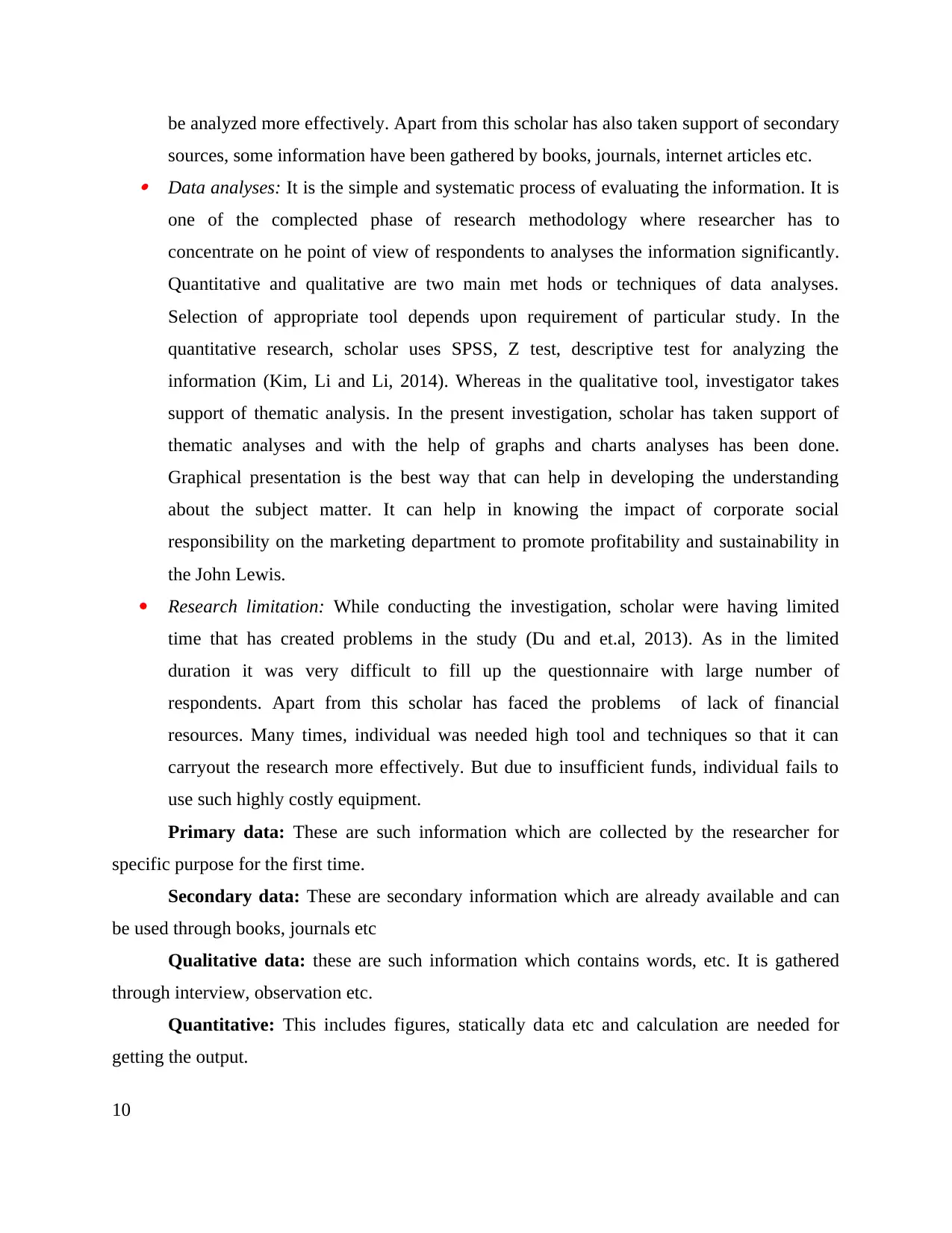
be analyzed more effectively. Apart from this scholar has also taken support of secondary
sources, some information have been gathered by books, journals, internet articles etc. Data analyses: It is the simple and systematic process of evaluating the information. It is
one of the complected phase of research methodology where researcher has to
concentrate on he point of view of respondents to analyses the information significantly.
Quantitative and qualitative are two main met hods or techniques of data analyses.
Selection of appropriate tool depends upon requirement of particular study. In the
quantitative research, scholar uses SPSS, Z test, descriptive test for analyzing the
information (Kim, Li and Li, 2014). Whereas in the qualitative tool, investigator takes
support of thematic analysis. In the present investigation, scholar has taken support of
thematic analyses and with the help of graphs and charts analyses has been done.
Graphical presentation is the best way that can help in developing the understanding
about the subject matter. It can help in knowing the impact of corporate social
responsibility on the marketing department to promote profitability and sustainability in
the John Lewis.
Research limitation: While conducting the investigation, scholar were having limited
time that has created problems in the study (Du and et.al, 2013). As in the limited
duration it was very difficult to fill up the questionnaire with large number of
respondents. Apart from this scholar has faced the problems of lack of financial
resources. Many times, individual was needed high tool and techniques so that it can
carryout the research more effectively. But due to insufficient funds, individual fails to
use such highly costly equipment.
Primary data: These are such information which are collected by the researcher for
specific purpose for the first time.
Secondary data: These are secondary information which are already available and can
be used through books, journals etc
Qualitative data: these are such information which contains words, etc. It is gathered
through interview, observation etc.
Quantitative: This includes figures, statically data etc and calculation are needed for
getting the output.
10
sources, some information have been gathered by books, journals, internet articles etc. Data analyses: It is the simple and systematic process of evaluating the information. It is
one of the complected phase of research methodology where researcher has to
concentrate on he point of view of respondents to analyses the information significantly.
Quantitative and qualitative are two main met hods or techniques of data analyses.
Selection of appropriate tool depends upon requirement of particular study. In the
quantitative research, scholar uses SPSS, Z test, descriptive test for analyzing the
information (Kim, Li and Li, 2014). Whereas in the qualitative tool, investigator takes
support of thematic analysis. In the present investigation, scholar has taken support of
thematic analyses and with the help of graphs and charts analyses has been done.
Graphical presentation is the best way that can help in developing the understanding
about the subject matter. It can help in knowing the impact of corporate social
responsibility on the marketing department to promote profitability and sustainability in
the John Lewis.
Research limitation: While conducting the investigation, scholar were having limited
time that has created problems in the study (Du and et.al, 2013). As in the limited
duration it was very difficult to fill up the questionnaire with large number of
respondents. Apart from this scholar has faced the problems of lack of financial
resources. Many times, individual was needed high tool and techniques so that it can
carryout the research more effectively. But due to insufficient funds, individual fails to
use such highly costly equipment.
Primary data: These are such information which are collected by the researcher for
specific purpose for the first time.
Secondary data: These are secondary information which are already available and can
be used through books, journals etc
Qualitative data: these are such information which contains words, etc. It is gathered
through interview, observation etc.
Quantitative: This includes figures, statically data etc and calculation are needed for
getting the output.
10
Paraphrase This Document
Need a fresh take? Get an instant paraphrase of this document with our AI Paraphraser
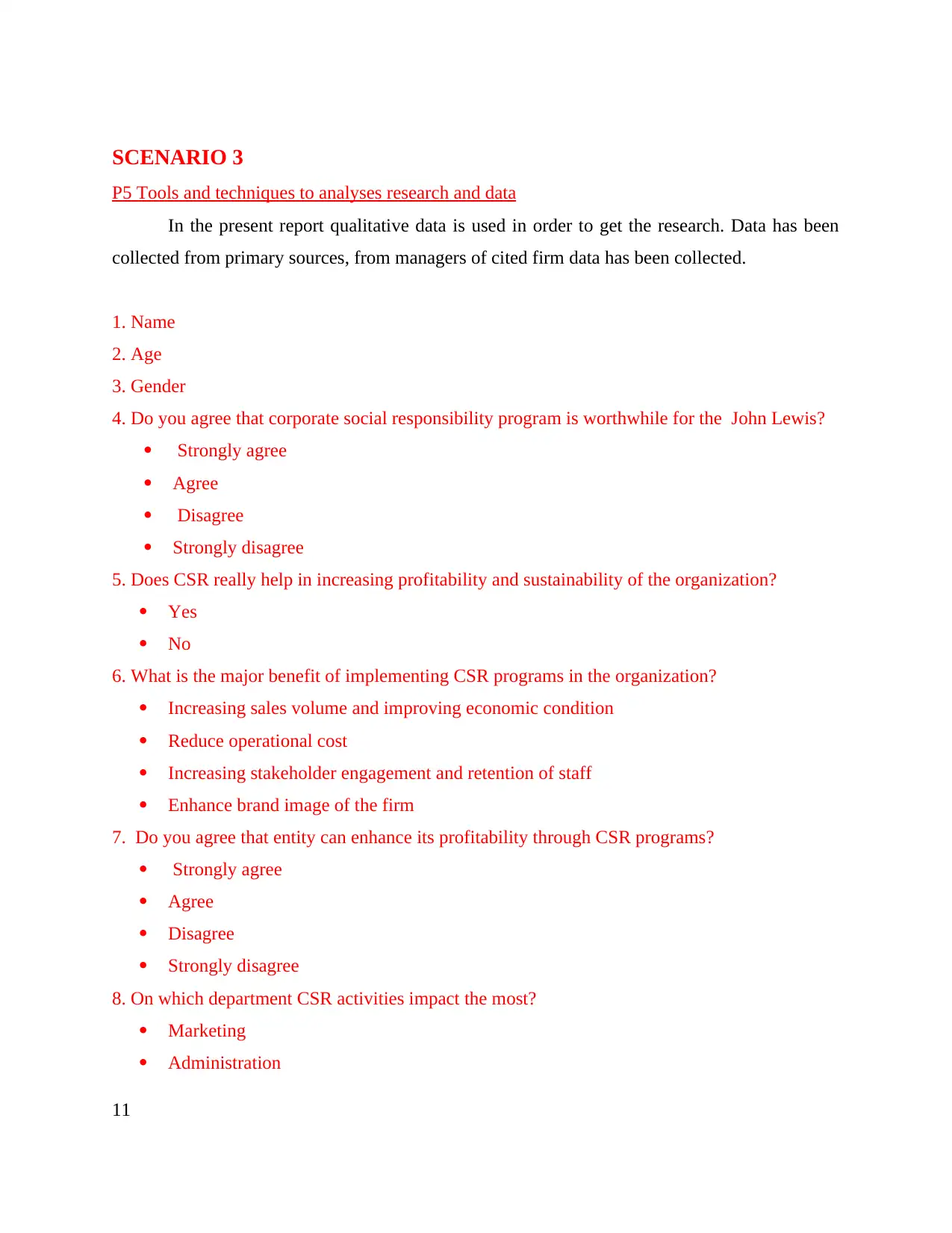
SCENARIO 3
P5 Tools and techniques to analyses research and data
In the present report qualitative data is used in order to get the research. Data has been
collected from primary sources, from managers of cited firm data has been collected.
1. Name
2. Age
3. Gender
4. Do you agree that corporate social responsibility program is worthwhile for the John Lewis?
Strongly agree
Agree
Disagree
Strongly disagree
5. Does CSR really help in increasing profitability and sustainability of the organization?
Yes
No
6. What is the major benefit of implementing CSR programs in the organization?
Increasing sales volume and improving economic condition
Reduce operational cost
Increasing stakeholder engagement and retention of staff
Enhance brand image of the firm
7. Do you agree that entity can enhance its profitability through CSR programs?
Strongly agree
Agree
Disagree
Strongly disagree
8. On which department CSR activities impact the most?
Marketing
Administration
11
P5 Tools and techniques to analyses research and data
In the present report qualitative data is used in order to get the research. Data has been
collected from primary sources, from managers of cited firm data has been collected.
1. Name
2. Age
3. Gender
4. Do you agree that corporate social responsibility program is worthwhile for the John Lewis?
Strongly agree
Agree
Disagree
Strongly disagree
5. Does CSR really help in increasing profitability and sustainability of the organization?
Yes
No
6. What is the major benefit of implementing CSR programs in the organization?
Increasing sales volume and improving economic condition
Reduce operational cost
Increasing stakeholder engagement and retention of staff
Enhance brand image of the firm
7. Do you agree that entity can enhance its profitability through CSR programs?
Strongly agree
Agree
Disagree
Strongly disagree
8. On which department CSR activities impact the most?
Marketing
Administration
11

Production
Finance
9. Suggest ways that can help in increasing profitability and sustainability of John Lewis
through CSR activities?
Theme 1
corporate social responsibility program is worthwhile for the John Lewis
Strongly agree 7
Agree 4
Disagree 3
Strongly disagree 1
Interpretation: From the above research it can be said that seven managers of John Lewis are
strongly agreed on the point that CSR is worthwhile for the cited firm. Four respond ants said
that they are agreed that it is worthwhile (Lund-Thomsen and Lindgreen, 2014). Three answers
viewed that they are disagreed with the point and one respondent is completely disagreed with
this point of view. So it can be interpreted that corporate social responsibility is an essential
function for the organizations and can give optimistic results to the John Lewis. With the help of
this activity company will be able to accomplish its objective of increasing profitability and
sustainability significantly (Hopkins, 2016).
12
Strongly agree
Agree
Disagree
Strongly disagree
0 1 2 3 4 5 6 7 8
7
4
3
1
Column F
Finance
9. Suggest ways that can help in increasing profitability and sustainability of John Lewis
through CSR activities?
Theme 1
corporate social responsibility program is worthwhile for the John Lewis
Strongly agree 7
Agree 4
Disagree 3
Strongly disagree 1
Interpretation: From the above research it can be said that seven managers of John Lewis are
strongly agreed on the point that CSR is worthwhile for the cited firm. Four respond ants said
that they are agreed that it is worthwhile (Lund-Thomsen and Lindgreen, 2014). Three answers
viewed that they are disagreed with the point and one respondent is completely disagreed with
this point of view. So it can be interpreted that corporate social responsibility is an essential
function for the organizations and can give optimistic results to the John Lewis. With the help of
this activity company will be able to accomplish its objective of increasing profitability and
sustainability significantly (Hopkins, 2016).
12
Strongly agree
Agree
Disagree
Strongly disagree
0 1 2 3 4 5 6 7 8
7
4
3
1
Column F
⊘ This is a preview!⊘
Do you want full access?
Subscribe today to unlock all pages.

Trusted by 1+ million students worldwide
1 out of 20
Related Documents
Your All-in-One AI-Powered Toolkit for Academic Success.
+13062052269
info@desklib.com
Available 24*7 on WhatsApp / Email
![[object Object]](/_next/static/media/star-bottom.7253800d.svg)
Unlock your academic potential
Copyright © 2020–2025 A2Z Services. All Rights Reserved. Developed and managed by ZUCOL.





